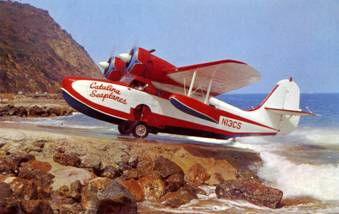A Too-Brief History of Grumman
Beginnings
Late in 1929, America's aircraft industry was young, improvisational, and - given the recent crash of the stock market - uncertain. Much of the industry was moving to the central Long Island plains, which had not yet erupted into suburbs. Blessed with a "we can do it" attitude, several young men joined together to form a new company, which would be led by Leroy Grumman. As a new aviation company, it needed income to survive "until the business took off" (so to speak). At first, while it pondered how to make its mark, the company sustained itself by doing specialized work for other companies, such as welding aluminum tubing.
Grumman soon found a way to make that mark. In an era in which airplanes could land only on water, or only on land, it built airplane floats with retractable wheeled landing gear. For the first time, an airplane could be based either on land or on water. For that matter, if landing gear that retracted would work for float planes, it would work for land planes, too. Grumman built the first biplane with retractable landing gear. Suddenly, land-based airplanes could fly a little faster (because of reduced drag) and a little further (with less drag, they burned less fuel per mile).
World War II
Grumman's airplanes rapidly began earning the company respect, particularly with regard to the U.S. Navy. Continuing to innovate as the 1930s progressed, the company demonstrated exceptional prowess with fold-and-stow wing designs, and it earned a presence on the flight decks of America's aircraft carriers. Grumman Wildcats, Hellcats, and Avengers would eventually be at the core of America's naval airpower in the Pacific Theatre during World War II.

Deploying folded wings before flight:
a Hellcat aboard USS Yorktown
Wikimedia Commons; Ray Wagner Collection

Grumman Goose at Santa Catalina
Tom Wigley photograph
https://www.flickr.com/photos/amphalon/8428551579
The company also penetrated the civilian market, making amphibious aircraft that floated on their hulls. One of these, the Goose, was a dual milestone for Grumman - its first monoplane, and also its first multi-engine aircraft. Built for commuting and small coastal airlines, it also saw service as a light military transport.
Post-War Years
As the Cold War set in, Grumman's markets multiplied:
- It continued to develop and build front-line naval fighting aircraft.
- It developed and built the Navy's first purpose-made anti-submarine aircraft.
- It developed and built the Navy's first early-warning aircraft.
- It developed and built the era's most successful amphibious rescue aircraft.
- It launched the Gulfstream business air transport project.
- It developed and built the Lunar Excursion Module for NASA's Apollo program.
Hicksville's Skies in the 1950s
Around 1950, the bulk of Grumman's manufacturing work migrated to Calverton, which left the runways at the Bethpage headquarters more quiet - but they were not completely silent. In the years that followed, there were numerous flights of private (i.e., business) aircraft, as Grumman executives and engineers met constantly with clients, project partners, and government officials. R&D work on existing aircraft sometimes continued. Now and then, one heard the urgent shriek of a Cougar or Tiger fighter as it climbed out of Bethpage.
During this time, aircraft of two types dominated Grumman's air traffic over Hicksville: anti-submarine and amphibious rescue.

